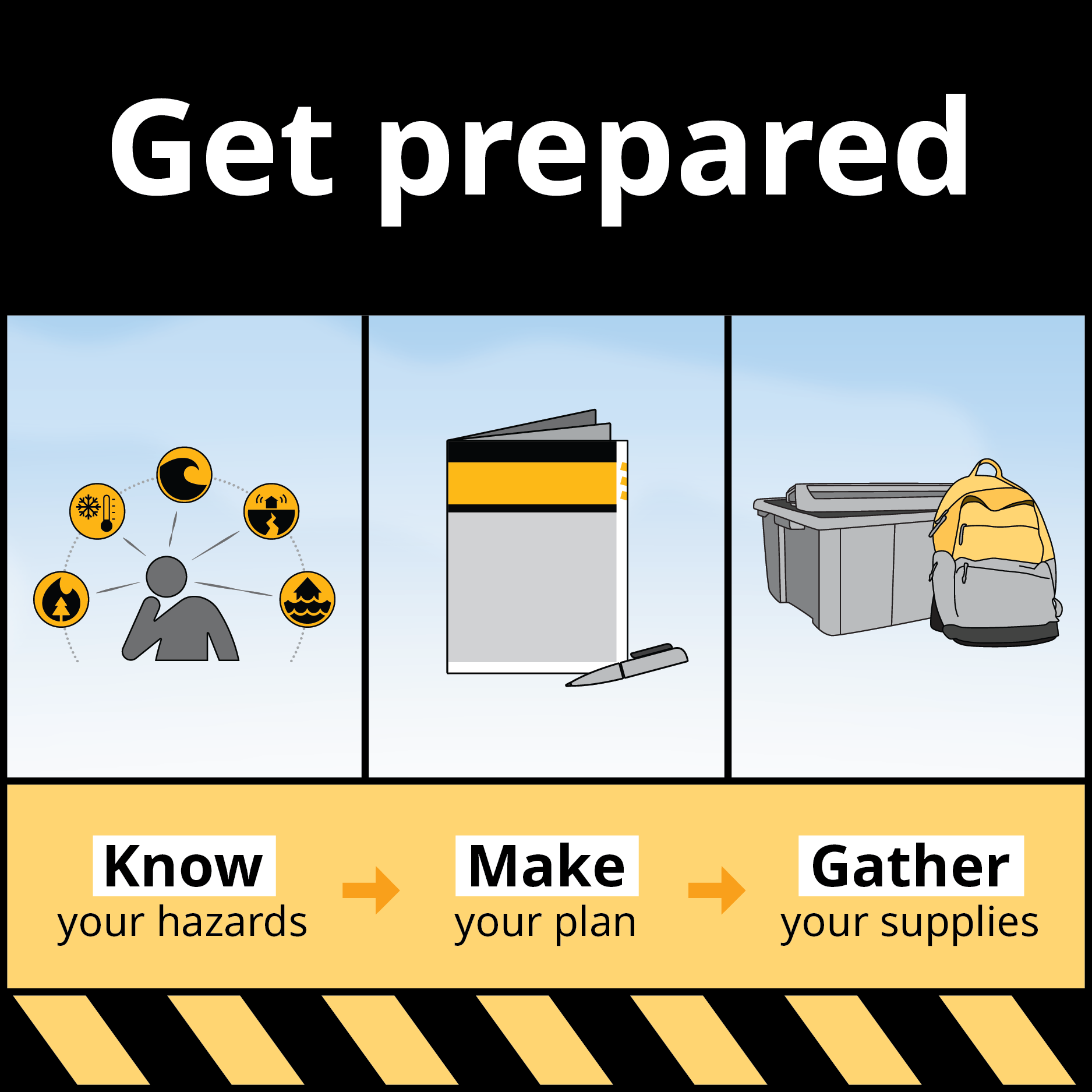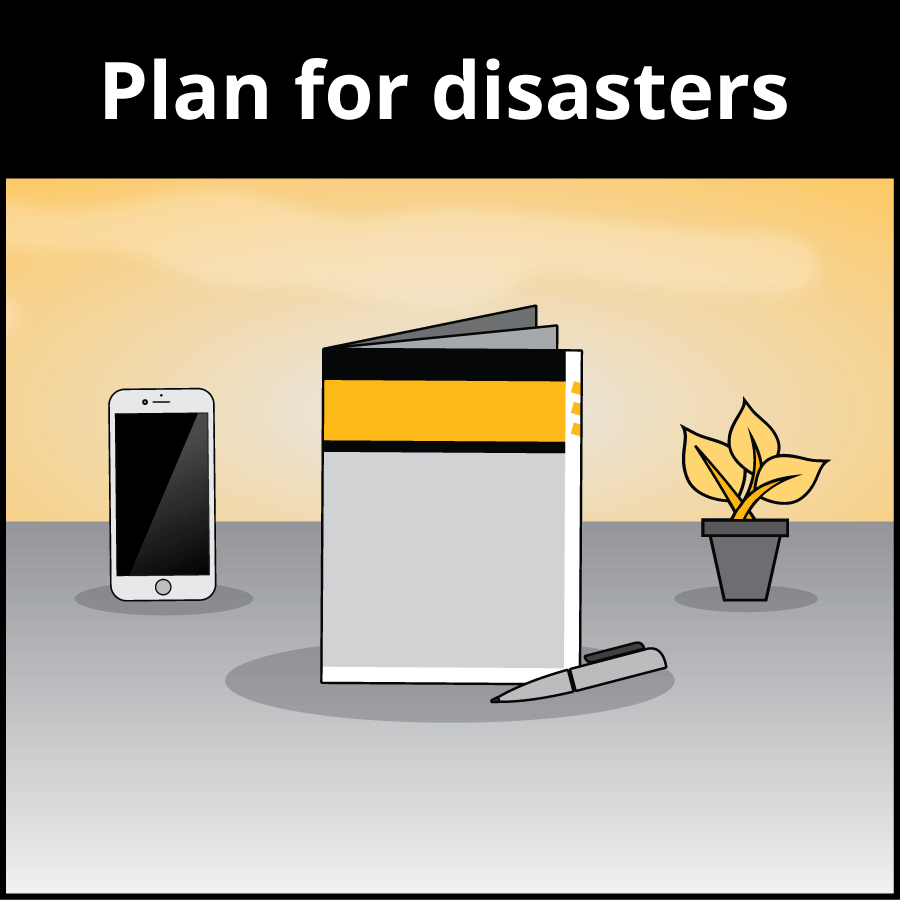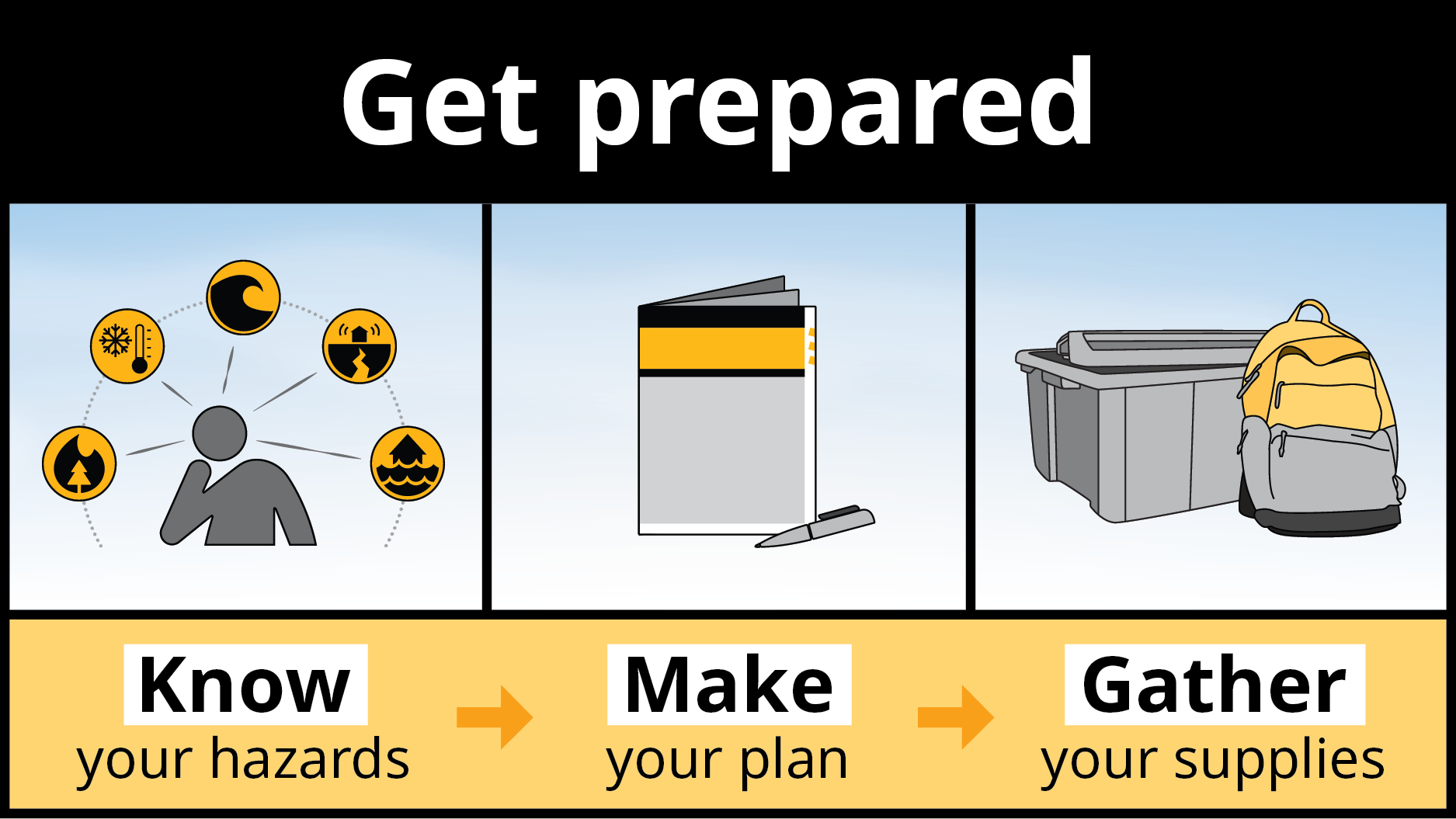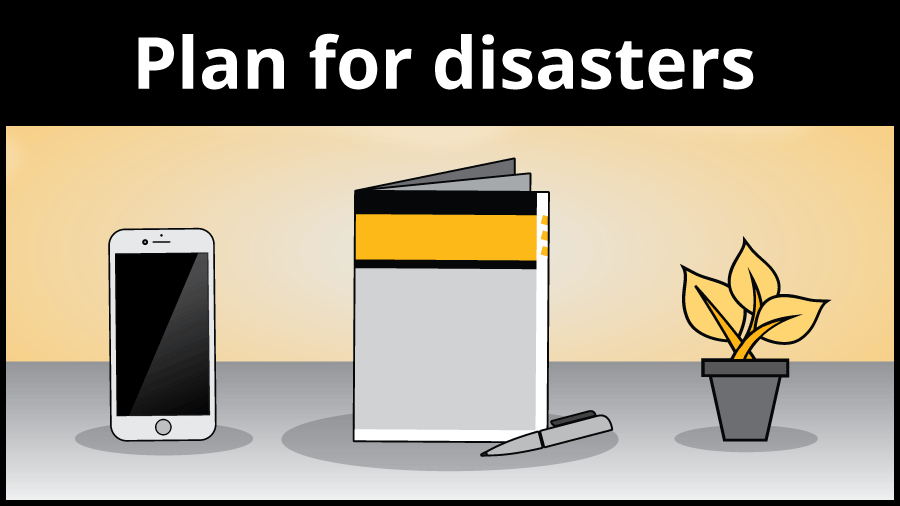General preparedness social media package
Preparing your home, your loved ones and yourself is an important step toward building resilient communities. Engage your followers with these easy-to-use, pre-written social media content and graphics. Post this content directly to your own social media channels or follow PreparedBC on Facebook, Instagram, and X (formerly Twitter) to share our posts!
Instructions for posting
- Copy-and-paste the content below in a new post
- Download, then attach the graphics below
- Option: add information, photos and hashtags specific to your community
- Double check the links and tagged accounts before you post
Graphics
Facebook / Instagram


X (formerly Twitter)


Content
X
Know your hazards
Get prepared for the hazards specific to our area. Some of the hazards that could happen here are (LIST LOCAL HAZARDS). Learn more from Prepared BC: http://ow.ly/M5Cy30qMmJy
Before you make an emergency plan, you’ll need to know what you’re planning for! Some of the hazards that could happen here are (LIST LOCAL HAZARDS). Learn more from Prepared BC: http://ow.ly/M5Cy30qMmJy
Make a plan
Making a plan is an important part of getting prepared. Talk to the people you live with about how you will prepare for and respond to an emergency. Use the @PreparedBC fill-in-the blanks emergency plan or interactive Emergency Ready Planner: preparedbc.ca/EmergencyPlan
Making an emergency plan can be as easy as filling in the blanks! Start today with the @PreparedBC interactive Emergency Ready Planner or by downloading a fillable plan: preparedbc.ca/EmergencyPlan
Emergency plans are not one-size-fits-all. Visit @PreparedBC to learn how to customize your plan to the unique needs of your home and everyone in it: preparedbc.ca/EmergencyPlan
Everyone needs an emergency plan. Being prepared can help you act quickly and calmly and bounce back faster following an emergency. Learn how at @PreparedBC: preparedbc.ca/EmergencyPlan
Creating an emergency plan doesn’t cost a penny! Use the printable fill-in-the-blanks Home Emergency Plan or interactive Emergency Ready Planner: preparedbc.ca/EmergencyPlan
An important part of your emergency plan is knowing how you’ll keep in touch with your loved ones. Designate an emergency contact outside your area too! Learn more: preparedbc.ca/EmergencyPlan
Build an emergency kit
During a severe storm or earthquake, you’ll need an emergency kit if you have to shelter on your property. Learn how to build one at: preparedbc.ca/emergencykit
Emergency kits don’t have to be expensive. You probably already have many of the basics around your house! Visit @PreparedBC to learn what you should include: preparedbc.ca/emergencykit
Food & water aren’t the only things you need in an emergency kit. @PreparedBC can help you build a kit customized to your location and unique needs: preparedbc.ca/emergencykit
Building an emergency kit can be affordable, especially if you put it together over time. Just set a reminder to add 2-3 items a week over a few months. @PreparedBC has more budget tips. preparedbc.ca/emergencykit
Pack grab-and-go bags
You’ll need a grab-and-go bag if you have to evacuate on short notice during emergencies like floods or wildfires. Learn the difference between an emergency kit and a grab-and-go bag at: preparedbc.ca/grab-and-go @PreparedBC
Everyone you live with should have their own grab-and-go bag. Once you have the basics, add personal items like medications, extra eyeglasses and comfort items for kids. Visit @PreparedBC to learn more about building personalized grab-and-go bags: preparedbc.ca/grab-and-go
During a wildfire or flood, you may not be able to return home before you have to evacuate. Keep grab-and-go bags in your vehicle, at work and at school. Visit @PreparedBC to learn how to build yours: preparedbc.ca/grab-and-go
A grab-and-go bag is a smaller version of an emergency kit that should be kept in an easily accessible place – ready to go if you have to leave on short notice. Everyone needs their own. Keep one in your vehicle, at work and at school. Learn more at: preparedbc.ca/grab-and-go
Grab-and-go bags don’t have to be fancy or expensive. You probably already have most of what you need around the house. Visit @PreparedBC for tips on building your grab-and-go bag: preparedbc.ca/grab-and-go
Communicating during a disaster
How will you reach your loved ones in an emergency? Make sure communication is part of your plan. Get started with @PreparedBC’s fill-in-the-blanks emergency plan: preparedbc.ca/emergencyplan
Sometimes phone lines can get jammed during an emergency. Make sure the people you live with have a backup plan so that everyone can get in touch. A private social media group is a great option! Make your emergency plan today: preparedbc.ca/emergencyplan
DYK you should designate an out-of-province emergency contact? Someone who lives far away & doesn’t face the same hazards, can act as a check-in if you're having trouble reaching people locally. Learn how to make your emergency plan: preparedbc.ca/emergencyplan
During an emergency, returning home might not be the safest option for you and the people you live with. Agree on an emergency meeting place so everyone knows how to reunite. Visit @PreparedBC to make your plan: preparedbc.ca/emergencyplan
We’re all in this together. Meet your neighbours & talk about how you can support each other during an emergency. Include their contact info in your plan and encourage them to make a plan, too. @PreparedBC can help you start the conversation: preparedbc.ca/emergencyplan
Planning and preparing for older adults and those with additional needs
If you have an older family member, take time to make an emergency plan with them. Creating a support network and a grab-and-go bag for them can make a big difference in case of emergency. Learn how at @PreparedBC: preparedbc.ca/emergencyplan
If you or someone close to you has a disability, make an emergency plan and pack grab-and-go bags with things like extra medications, eyeglasses & special equipment. These are important to pack in case of emergency. @PreparedBC can help: preparedbc.ca/emergencyplan
We’re all in it together. A support network is important for those with mobility limitations, disabilities or medical needs. Learn how to create your own support network or offer support to someone you know: preparedbc.ca/emergencyplan
If you or someone you’re close to has a disability, planning for an emergency is extra important. If you have to shelter at home, you’ll need an emergency kit and a support network to help. Visit @PreparedBC to learn more: preparedbc.ca/emergencyplan
Planning and preparing for your pets
During an emergency, if it’s not safe for you, it’s not safe for your pets! Have an evacuation plan that includes where you and your pets will go. Visit @PreparedBC for more information on preparing for your pets: preparedbc.ca/emergencyplan
Your pets need a grab-and-go bag too! Once you’ve packed the basics like food, leashes and carriers, consider comfort items like a towel or shirt that smells like you. This will help keep them calm in an emergency. Learn more @PreparedBC: preparedbc.ca/emergencyplan
Remember to add your pets’ information to your emergency plan. Things like vet info, microchip number and vaccination history are important to have. Learn how to prepare for your pets: preparedbc.ca/emergencyplan
Facebook or Instagram
Know your hazards
Can you name some of the most common hazards in B.C.? Different hazards can happen in each area of the province, but all of them require having a plan and getting prepared. Here are some of the ones that can happen in our community (EDIT THE LIST BELOW TO ONLY INCLUDE RELEVANT ONES IN YOUR COMMUNITY)
✔️Floods
✔️Landslides
✔️Tsunamis
✔️Avalanches
✔️Disease outbreaks
✔️Earthquakes
✔️Wildfires
✔️Hazardous material spills
✔️Severe weather
Visit PreparedBC.ca/hazards to learn more.
Make a plan
Planning for a potential emergency just got easier thanks to the PreparedBC interactive Emergency Ready Planner. You can also print a copy of the fill-in-the-blanks Home Emergency Plan.
Complete either option to help you remain calm, focused, and safe during an emergency. PreparedBC.ca/emergencyplan
Your emergency plan should be as unique as you are. Visit PreparedBC to learn how to account for the needs of everyone in your home. Use the interactive Emergency Ready Plan or download the fill-in-the-blanks version and you’ll be done before you know it: PreparedBC.ca/emergencyplan
An emergency plan isn’t just a contact list. Visit PreparedBC to learn how to build a plan that includes the needs of everyone in your life, from children and pets to older adults and more! Get started: PreparedBC.ca/emergencyplan
Build an emergency kit
Following a disaster, you may need to stay at home with no power or running water. Your emergency kit will help. Gather supplies that will support the people you live with for a minimum of 3 days to 2 weeks and store them in an easy-to-access place. Some things to include:
✔️Water and non-perishable food
✔️Battery-powered or hand crank radio & flashlight
✔️First aid kit
✔️Copy of your emergency plan
Get the complete list at Prepared BC: preparedbc.ca/emergencykit
Building a home emergency kit doesn’t have to be costly. You probably already have items on hand to start building one today. Here are a few things to check for:
✔️Extra seasonal clothes and shoes – save a few items from your donation pile
✔️Toiletries – travel size bottles work great
✔️Garbage bags – take a few out of the box and put them in your kit
Visit Prepared BC for more: preparedbc.ca/emergencykit
If disaster strikes, you may be required to shelter at home with no power or running water. Learn how to build an emergency kit so you’ll be prepared to “camp at home” safely. You probably already have a few things to get started!
Visit Prepared BC to learn how: preparedbc.ca/emergencykit
Your home emergency kit can help you stay healthy and safe if you have to shelter at home following events like a damaging earthquake or severe storm. Gather supplies, pack them in large containers or totes and store them in an easy-to-access location. Here's what you need.
✔️Non-perishable food: 3 days to 2 weeks' supply. Don't forget the manual can opener
✔️Water: four litres per person, per day for drinking and sanitation
✔️Phone charger and battery bank
✔️Radio, hand-crank or battery-powered
✔️Flashlight, hand-crank or battery powered
✔️Extra batteries
✔️First-aid kit and medications
✔️Toiletries and personal items, such as an extra pair of glasses or contact lenses
✔️Copy of your emergency plan and copies of important documents, such as insurance papers
✔️Garbage bags and moist towelettes for sanitation
✔️Seasonal clothing, sturdy footwear and emergency blanket
Visit Prepared BC to learn more: preparedbc.ca/emergencykit
What’s the difference between an emergency kit and a grab-and-go bag? You’ll need a grab-and-go bag in the event you have to leave your home during an emergency. This may happen with little notice. You’ll need an emergency kit if you have to “camp at home” during an emergency with no power or running water.
Learn how to pack both: preparedbc.ca/emergencykit
Pack grab-and-go bags
In the event of an emergency, you may be asked to evacuate your home with little notice. Have a grab-and-go bag prepared so you’ll have everything you need with you. Learn what to include and how to personalize a bag for everyone you live with: preparedbc.ca/grab-and-go
Have an old backpack or duffel bag destined for donation? Use it as your grab-and-go bag! You probably already have many of the items you need around the house. Visit Prepared BC to learn how to build yours: preparedbc.ca/grab-and-go
You’ve packed your grab-and-go bag with the recommended essentials, now consider adding a few comfort items. Here are a few suggestions to help keep you calm and entertained if you can’t return home for a while.
️✔️Treats like your favourite chocolate bar or fruit snack
✔️An old favourite sweater
✔️Favourite, uplifting book
✔️Journal and pen
✔️ Deck of playing cards or crossword puzzles
More Prepared BC tips for building your grab-and-go bag: preparedbc.ca/grab-and-go
Comfort items are especially important in children’s grab-and-go bags. Ask your child to set aside a special stuffed animal that can be their buddy if you have to leave home for a while. Remember to pack a few non-perishable treats and snacks too! Visit Prepared BC for advice: preparedbc.ca/grab-and-go
Communicating during a disaster
How will your friends and family get in touch during an emergency if phone lines are jammed? Make a private social media group and practice checking in. You never know when you’ll need it!
Visit Prepared BC to learn more about emergency planning: preparedbc.ca/emergencyplan
Friends and family members aren’t the only people you may need to get in touch with during an emergency. You will also want contact information for:
✔️ Your childrens’ schools
✔️ Your out-of-area contact
✔️ Your neighbours
✔️ Your landlord
✔️ Your utility companies
Learn more about making your emergency plan: preparedbc.ca/emergencyplan
Have you made an emergency plan yet? You’ll need to know where to get the latest information in case of an emergency. Remember to bookmark [YOUR CITY/ORGANIZATION NAME’S] official channels.
✔️ [LIST YOUR CHANNELS HERE]
✔️ [INCLUDE SOCIAL MEDIA ACCOUNTS]
✔️ [AND OFFICIAL WEBSITE]
Learn more about planning and preparing for emergencies: preparedbc.ca/emergencyplan
Planning and preparing for older adults and those with additional needs
If you have older friends, family or neighbours, ask if they have an emergency plan or would like help making one. Those with mobility limitations or medical needs will especially benefit from a plan and support network that can help during an emergency. We’re all in it together.
Visit Prepared BC to learn how you can help: preparedbc.ca/emergencyplan
If you have a disability or medical needs, make sure to have a grab-and-go bag prepared in case you need to leave on short notice. It should include critical medications or special equipment. Other things to consider as part of your planning:
✔️ Communication challenges you may encounter
✔️ Unfamiliar or hard-to-navigate environments
✔️ Your service animal’s needs
Visit Prepared BC to learn more: preparedbc.ca/emergencyplan
If you or someone close to you has a disability or mobility limitations, having a support network can help you during an emergency. Your network can include friends, family, caregivers and neighbours. When building your support network also consider:
✔️ Giving trusted people access to your home so they can check on you
✔️ Showing them where your emergency plan & supplies are
✔️ Agreeing to notify each other when you’re going out of town
Visit Prepared BC to learn more: preparedbc.ca/emergencyplan
Planning and preparing for your pets
DYK your pet needs a grab-and-go bag too? If you have to leave home on short notice, make sure you take their grab-and-go bag which should include:
✔️ Food, water and treats
✔️ Leash or harness
✔️ Extra medications and comfort items
✔️ ID, vaccination & medical info
Learn more about planning for your pets at: preparedbc.ca/emergencyplan
Emergencies can be extra stressful for our pets. When packing your pet’s grab-and-go bag, consider adding comfort items like an old towel or shirt that smells like you. Your scent can help keep them calm. Other things like a favourite toy and treats can also help your pet feel more comfortable during an emergency.
Visit Prepared BC to learn how to include your pets in your emergency plan, and how to pack them a special grab-and-go bag: preparedbc.ca/emergencyplan
